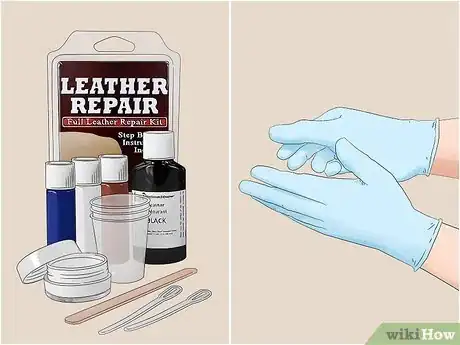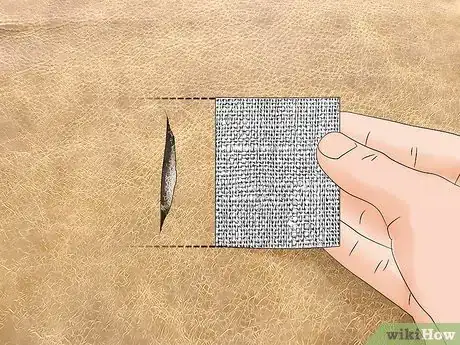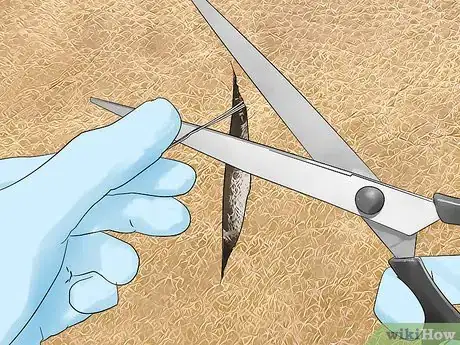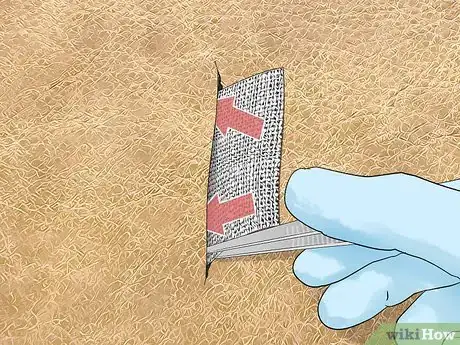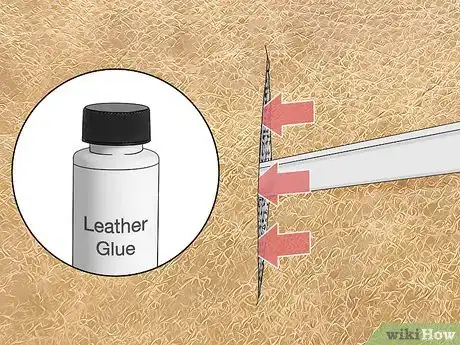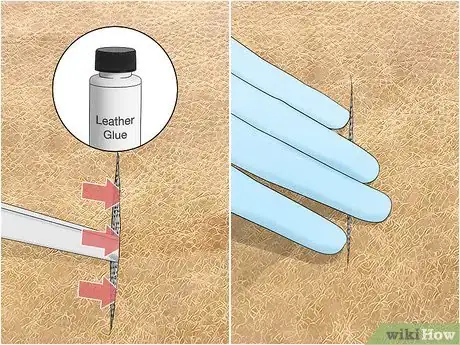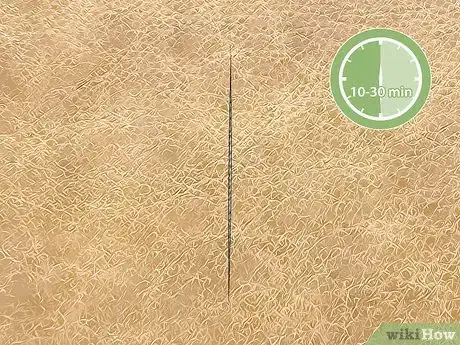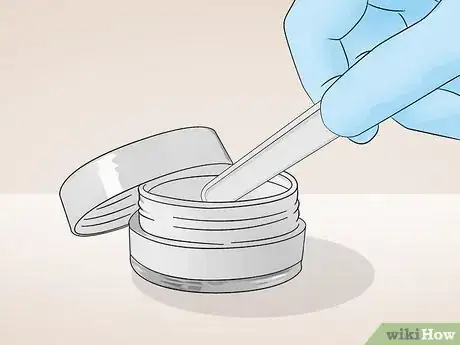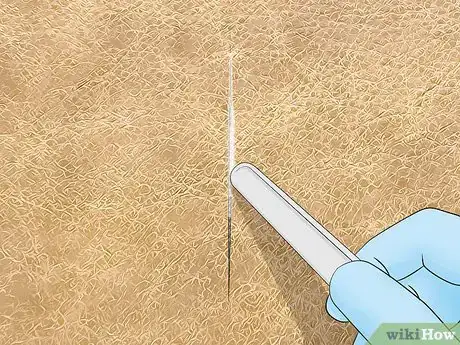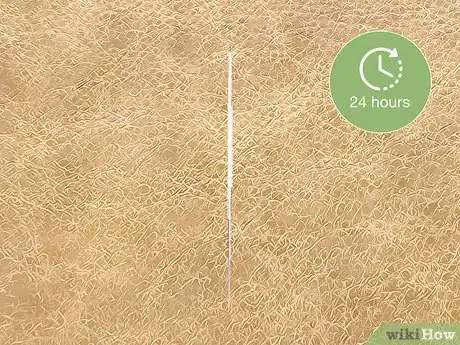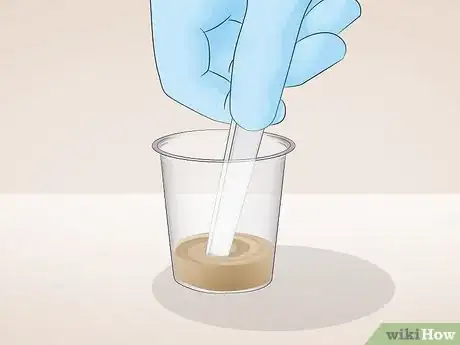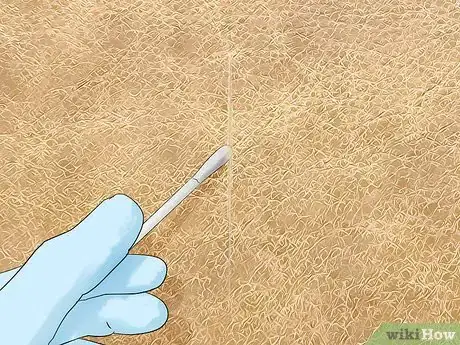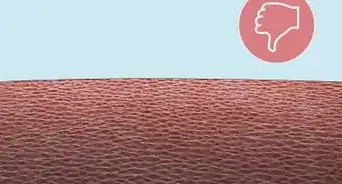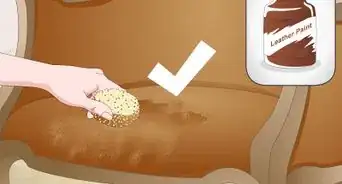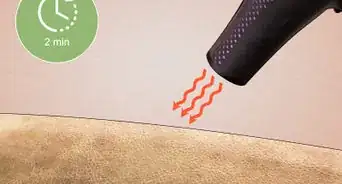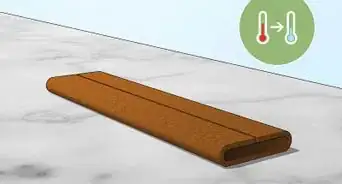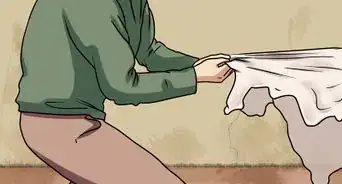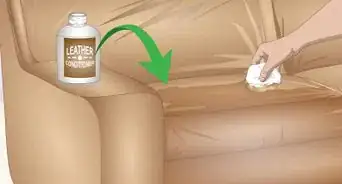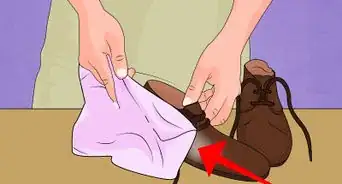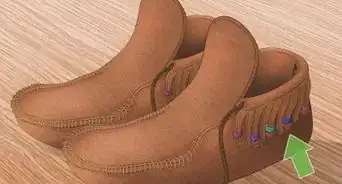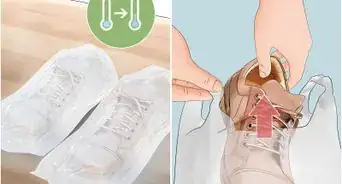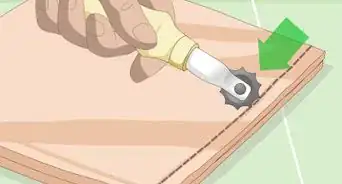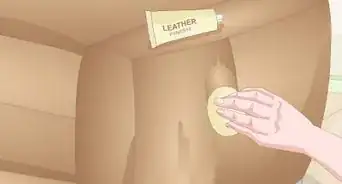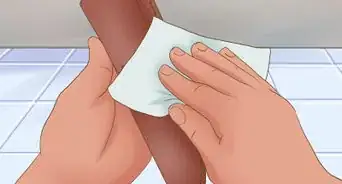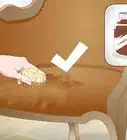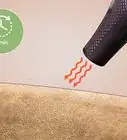This article was co-authored by Mallika Sharma and by wikiHow staff writer, Eric McClure. Mallika Sharma is a Certified Leather Care Technician and the Founder of The Leather Laundry, a niche spa service for luxury leather gear in India. Mallika specializes in leather cleaning, coloring, repairing, and restoring for shoes, handbags, jackets, wallets, belts, and sofas. She holds a Master’s degree in Finance and Investment from the University of Edinburgh Business School. Mallika is a certified Professional Leather Care Technician and trained with the globally reputed leather care company, LTT in the United Kingdom.
There are 11 references cited in this article, which can be found at the bottom of the page.
This article has been viewed 60,964 times.
Repairing a leather tear can be a little time consuming, but it shouldn’t be excessively difficult if the damage is relatively small. To fix a leather tear, get a leather repair kit with a color compound that matches the color of your leather. To use the kit, slide the special fabric patch under the tear, glue it in place, and fill in the gap with the leather filling solution. This process works best on tears that are less than 6–7 inches (15–18 cm) in length and smaller than 2–3 inches (5.1–7.6 cm) in width. If you have a hole or major tear, you’re better off taking your leather to a professional leather repair shop.
Steps
Inserting Your Repair Patch
-
1Get some nitrile gloves and a leather repair kit. To repair a tear in leather, purchase a leather repair kit. They are all basically the same, except some kits rely on heat instead of glue. The kits that require heat are easier to use, but they tend to be much weaker. Purchase a kit with a color compound that matches your leather. Put on some nitrile gloves before patching your leather to keep your hands clean.[1]
- This will work for any minor tear where none of the leather has been removed. Holes and large rips with missing chunks of leather requires the help of a professional to patch and retreat it.
- Repair kits come with a fabric patch, leather glue, palette knife, tweezers, and leather finish.
- Purchase a leather repair kit online. You may be able to find specialized kits at an auto repair or furniture shop.
-
2Cut a portion of the patching fabric out to be slightly bigger than your tear. You can do this without measuring if your tear is small. If the tear is larger, measure its dimension with a measuring tape. Cut out a piece of the patching fabric using scissors so that it is at least 1 in (2.5 cm) bigger than the tear on all sides.[2]
- You are going to glue the patch to the underside of the tear. It needs to be a little bigger than the tear itself so that there’s room for the glue to stick to the fabric.
- If you have a very small tear, you might not need to use a patch—just use the leather glue to paste the torn piece back into place, then finish with filler cream.[3]
Advertisement -
3Trim any loose strips off of the tear using scissors. Inspect your leather tear. If there are lose pieces of shredded leather or fabric, trim them off using scissors. The cleaner your tear is, the easier it is to repair. This also reduces the odds that your tear reopens in the future.[4]
-
4Use tweezers to slide the patch under the fabric. Grip the fabric patch gently with your tweezers. Lift an edge of the tear up a little and slide the fabric into the opening between the leather and the cushion or lining underneath. Once the fabric is under one portion of the leather, gently lift the opposite side of the tear and slide the patch over. Release the patch once it looks like the fabric is totally filling the gap in the leather.[5]
- Do your best to smooth it out with the dull side of your tweezers and thumbs.
Variation: If you’re having trouble getting the patch to lay flat in the center of the tear and you’re repairing a car seat, sofa, or thick jacket, hold the patch over the opening on top of the leather. Then, push a safety pin into the patch in the center of the tear. This will keep the fabric from sliding around while you push the patch under each side of the tear.
Gluing the Leather to the Patch
-
1Lift the tear up on one side and apply leather glue underneath it. Scoop a small amount of leather glue up with your palette knife. Gently lift up one edge of the tear and slide the palette knife into the opening between the leather and the interior side of the fabric. Then, brush your palette knife against the interior side of the fabric. Slide the knife back and forth to apply the glue to the underside of the leather surface.[6]
- Some repair kits use heat instead of glue to adhere the patch to the leather. On these kits, use a hair dryer or iron to heat the patch and activate the adhesive that is built into the fabric.
- If your tear has more than 2 sides, repeat these steps for every side of the tear.
Tip: If the opening is really small, use a toothpick or popsicle stick to lift the leather up. If the tear is on the larger side, you may need to use a toothpick or popsicle stick to hold the leather up while you reload the palette knife with more glue.
-
2Push the fabric down and apply pressure to the glue. Remove your palette knife, popsicle stick, or toothpick. Press the leather down into the fabric or cushioning underneath. Do this at a slight angle towards the center of the tear so that your first glued side meets the fabric or cushion underneath as close to the middle of the tear as possible.[7]
-
3Repeat this process by gluing and pushing the other side of the tear. With your first edge in place, gently raise the other side of the tear up. Load your palette knife with leather glue and slide it under the gap in the leather. Apply the leather glue and push the fabric down at an angle towards the other side of the tear.[8]
- The smaller you can make the gap between the 2 edges of the tear, the easier it will be to make the repair job a breeze.
-
4Wait for the glue to dry or heat it with a hair dryer per the instructions. Some repair kits require you to wait for 10-30 minutes to let the glue dry. Other kits require heat to dry the glue out. Consult your repair kit’s instructions to determine how to dry your glue. If you aren’t sure how long you need to wait, let the glue dry for at least 6 hours, just to play it safe.[9]
- Some leather glues dry in 10-15 minutes. Others require hours of drying. It all depends on the brand and style of the leather glue.
Filling the Seam in the Tear
-
1Scoop some leather filler up in your palette knife. Wash your palette knife thoroughly with soap and water. Dry it with a clean paper towel. Then, scoop some leather filler up with your palette knife. Leather filler is a pasty substance that will harden when it dries, and is designed to fill in small gaps in leather materials.[10]
- Don’t worry about the color of the leather filler. You’re going to paint over it when you’re done filling the gap.
Tip: Even if it looks like there isn’t much of a gap between your torn edges, you still need the filler to act as a bonding agent to hold it in place. Otherwise, the tear will reopen over time.
-
2Apply filler to the seam in the tear using the side of the palette knife. Hold the blade of your palette knife on its side at a 45-degree angle. Lower it to one end of the tear and press the blade into the tear so that the filler is touching the end of the gap. Then, drag the knife over the entire length of the tear. Reload your knife as needed until you’ve completely filled the gap with the leather filler.[11]
- Do your best to make the filler flush with the surface of your leather.
- If you add too much filler or some of it ends up on the undamaged surface surrounding the tear, scrape it off with an unloaded edge of your palette knife.
-
3Wait 24 hours to give the glue and filler time to dry. Wash your palette knife and let the filler and glue dry. Leather filler can take quite a while to dry completely, so wait at least 24 hours to give it time to harden and settle.[12]
-
4Apply additional filler as needed to make the seam flush. Run your hand over the repaired tear. If there are no bumps and the leather feels smooth and even, you’re ready to move on. If it isn’t flush, add additional filler and let it dry. Sometimes it requires multiple coats of filler to smooth the tear out.[13]
- You can skip this step even if the repair doesn’t feel perfect. It’s completely up to you.
Painting and Finishing Your Leather
-
1Mix your color compound in a plastic cup. You may need to mix it yourself. To do this, choose the base color that looks closest to your leather’s original color and pour a little into a plastic cup. Add white or black until you have a color that closely resembles the original leather. Mix the color compound with a spoon, cotton swab, or brush[14]
- You shouldn’t need a lot of color compound to paint the seam. Don’t pour tons of compound into your cup. You can always mix more as needed.
- If your color is premixed, skip this step.
Tip: It is exceptionally difficult to match the color of leather perfectly, especially if the original leather is worn down or distressed. If you get moderately close, consider accepting the minor discrepancy. If the tear is minor, most people won’t notice anyway.
-
2Apply your color compound using a cotton swab. Dip the cotton swab into the color compound. Then, tap the loaded end of the cotton swab on top of the tear. Continue reloading your swab and tapping it on the tear until you can no longer see the original damage. Wait 1-2 hours for the color to completely dry, or follow the manufacturer’s instructions to determine the drying time.[15]
- If your tear is particularly large, you can use a paint brush instead.
-
3Dab some leather finish over the repair to give it the classic shine. Leather finish is kind of like leather conditioning oil, and will give your repaired section the traditional leather sheen. Pour some leather finish into a cotton pad and apply it to your repaired section using circular motions. Gently work it into the leather until it is absorbed in the fabric.[16]
- This step is entirely optional. If you’re happy with the way your repair looks, feel free to leave it as is.
Expert Q&A
Did you know you can get expert answers for this article?
Unlock expert answers by supporting wikiHow
-
QuestionHow do you fix a tear in leather?
 Mallika SharmaMallika Sharma is a Certified Leather Care Technician and the Founder of The Leather Laundry, a niche spa service for luxury leather gear in India. Mallika specializes in leather cleaning, coloring, repairing, and restoring for shoes, handbags, jackets, wallets, belts, and sofas. She holds a Master’s degree in Finance and Investment from the University of Edinburgh Business School. Mallika is a certified Professional Leather Care Technician and trained with the globally reputed leather care company, LTT in the United Kingdom.
Mallika SharmaMallika Sharma is a Certified Leather Care Technician and the Founder of The Leather Laundry, a niche spa service for luxury leather gear in India. Mallika specializes in leather cleaning, coloring, repairing, and restoring for shoes, handbags, jackets, wallets, belts, and sofas. She holds a Master’s degree in Finance and Investment from the University of Edinburgh Business School. Mallika is a certified Professional Leather Care Technician and trained with the globally reputed leather care company, LTT in the United Kingdom.
Certified Leather Care Technician
Things You’ll Need
- Leather repair kit
- Fabric patch
- Scissors
- Tweezers
- Safety pin (optional)
- Popsicle stick (optional)
- Toothpick (optional)
- Palette knife
- Leather glue
- Leather filler
- Hair dryer (optional)
- Color compound
- Leather finish
References
- ↑ https://www.readersdigest.ca/cars/maintenance/diy-car-maintenance-how-repair-leather-seat-your-car/
- ↑ https://youtu.be/agpq3wtrM50?t=27
- ↑ Mallika Sharma. Certified Leather Care Technician. Expert Interview. 14 December 2020.
- ↑ https://youtu.be/agpq3wtrM50?t=74
- ↑ https://youtu.be/agpq3wtrM50?t=38
- ↑ https://youtu.be/agpq3wtrM50?t=88
- ↑ https://youtu.be/agpq3wtrM50?t=90
- ↑ https://youtu.be/agpq3wtrM50?t=88
- ↑ https://www.readersdigest.ca/cars/maintenance/diy-car-maintenance-how-repair-leather-seat-your-car/
- ↑ Mallika Sharma. Certified Leather Care Technician. Expert Interview. 14 December 2020.
- ↑ https://youtu.be/agpq3wtrM50?t=146
- ↑ https://youtu.be/agpq3wtrM50?t=158
- ↑ https://living.thebump.com/patching-ripped-leather-sofa-8209.html
- ↑ https://living.thebump.com/patching-ripped-leather-sofa-8209.html
- ↑ https://living.thebump.com/patching-ripped-leather-sofa-8209.html
- ↑ https://youtu.be/agpq3wtrM50?t=255
